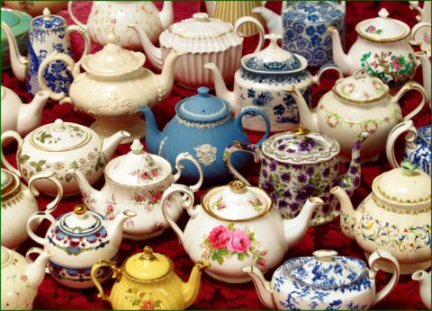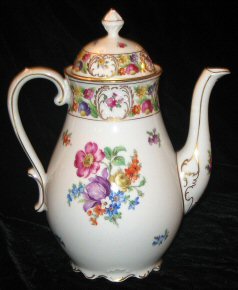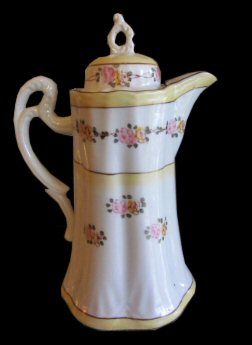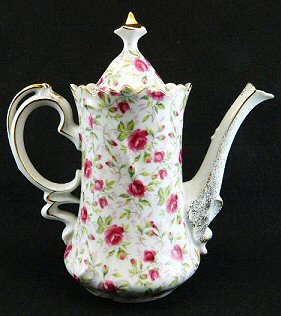
An Assortment Of Tea and Coffee Pots ~ No Chocolate Pots Here
Which Pot is Which?
Today many hostesses and hosts may not realize that there’s a difference between a Tea, Coffee and Chocolate pot. Each type of pot is designed to increase the flavor and enjoyment of its beverage within. And it’s all in the shape of the pot and the placement of the spout relative to the pot itself.
Hampshire County Council in the U.K. has a wonderful Brief History of the Teapot. They say the earliest known book on tea can be found in China in 780 AD under the Tang Dynasty (618-907).
We know tea was consumed thousands of years before. But it was during this dynasty that drinking tea became fashionable.
Tea doesn’t make it to the U.K. until 1648, but other European countries welcomed the new beverage a fair bit earlier. At the time the Brits utilized the pots that were typically shipped with the tea. The Chinese teapot was indistinguishable from what is termed a wine-pot or wine-ewer.

Teapot
A true distinction between wine-ewers and teapots was only established after 1694, when the British East India Company directed that teapots made for them in China must have “a grate… before the spout”. In other words, they wanted a sort of pierced barrier where the tea enters the spout so as to hold back the tea-leaves. ~ Hampshire County Council.
This began the evolution of the teapot into the proper serving vessel. Beginning with its shape, teapots are typically short and round. But if you find a tall pot you like, make sure it’s wide and round at the base. This extra space allows more room for the tea to move in the pot, which will promote the flavor of the tea leaves in the water. The spout of a tea pot is always in the center of the pot and its short in length. Presumably this makes it easier to clean the spout when tea leaves escape the grate and clog up spout. Eventually the grate gave way to cup strainers.
Chocolate beverages are known to have been part of the diet of Mayans as early as 460-480 AD. To make the chocolate drink, which was served cold, the Maya ground cocoa seeds into a paste and mixed it with water, cornmeal, chili peppers, and other ingredients. They then poured the drink back and forth from a cup to a pot until a thick foam developed. Chocolate was available to Maya of all social classes, although the wealthy drank chocolate from elaborately decorated vessels.
Cortés returned to Spain in 1528, bringing cocoa beans and chocolate drink making equipment. The Spaniards version of the “chocolatl” was said to be a beverage consisting of a chocolate base, flavored with vanilla and other spices that was served cold. It’s important to remember that sugar had not yet made its way into Europe and chocolate beverages were said to be an “acquired taste”.

Chocolate Pot
Cocoa was given as a dowry when members of the Spanish Royal Family married other European aristocrats. It was very expensive at the time, because the cocoa beans only grew in South America. Sweet-tasting hot chocolate was then invented, leading hot chocolate to become a luxury item among the European nobility by the 17th century. It was during this time that the Chocolate Pot came into favor.
Chocolate Pots are tall, somewhat slender with a small spout at the top. The cap on the top of the pot is wide enough to allow a wood frothier to emulsify the chocolate and release its full aroma. The frothier also helped to, well create a froth for serving. The spout at the top is wide and allows the froth to pour from the pot un-obstructed.
In the late 17th century, Hans Sloane, president of the Royal College of Physicians, visited Jamaica. There, he tried chocolate and considered it “nauseous”, but found it became more palatable when mixed with milk. When he returned to England, he brought the recipe with him, introducing milk chocolate to Europe. Adding milk to the ingredients also allowed for the creation of more frothing in the beverage and therefore the design of the chocolate pot became more important.
The National Coffee Association USA (NCAUSA) has a wonderful write-up on the History of Coffee. Basically, a goat herder in Ethiopia named Kaldi, noticed that when his goats ate berries from a certain tree, they became so spirited that they did not want to sleep at night. He reported his observation to the abbot at a local monastery who made a drink with the berries and discovered that it kept him alert for long hours during evening prayers.
News of the berries spread east and coffee moved into the Arabian peninsula. The Arabs were the first, not only to cultivate coffee but also to begin its trade. By the fifteenth century, coffee was being grown in the Yemeni district of Arabia and by the sixteenth century it was known in Persia, Egypt, Syria and Turkey. ~ NCAUSA

Coffee Pot
Europeans who traveled to the Near East found this new beverage and brought it back home to share with family and friends. By the 17th century coffee had made its way across Europe. But it wasn’t accepted by everyone. In 1615, Clergy in Venice condemned the drink as the “biter invention of Satan”. The controversy was so great that Pope Clement VIII was asked to make a decision on the drink. But upon trying the beverage, he liked it so much he gave it Papal approval.
In England ‘penny universities’ sprang up, so-called because for the price of a penny one could purchase a cup of coffee and engage in stimulating conversation. By the mid-17th century, there were over 300 coffee houses in London. Around this time, serving coffee from the coffee maker wasn’t practical as it was bulky and some what unsightly. Pouring the beverage into a Pot related the serving to the elegant appearance and practice of tea time.
To maintain the flavor of the coffee, a different pot had to be designed. Pots are more slender to help the heat stay in the beverage. Spreading it out as in a teapot disperses the heat and the coffee cools off to quickly. Additionally placing the spout at the bottom of the pot also helps the heat to remain in the pot. And finally making the spout long in comparison to a teapot, helps ensure the liquid doesn’t pour out too soon as the pot is turned for serving into a cup. Presumably ensuring that a Lady’s dress is not soiled by the sudden extraction of coffee from the pot.
Each Coffee, Tea and Chocolate Pot has been designed to enhance the flavor and consumption of its beverage. You might like to keep this in mind when you’re out looking for a new serving set.
https://victoriasrose.wordpress.com/2013/07/27/tea-coffee-chocolate-pots/
{Difference Between Coffee & Tea Cups}
Yesterday I did mention in my post that those chevrons, pointed at the particular cups in the end of my TV Interview's video, were wrong. So here I like to point out to you the visible differences between Coffee & Tea Cups.
Sorry for the poor photos, because of the camera focusing in on the windows... I placed each time two cups on an oak tray, placed on a ceramic pedestal. LEFT you see a Coffee Cup and to the RIGHT is a Tea Cup!
- Coffee cups are more narrow and mostly straight up. Teacups are lower and wider and often tapered down.
- The reason that teacups are wider at the top and more shallow is because a good tea is set with BOILING water.
- The bigger surface lets your tea cool down faster, to a consumable temperature.
To the left I also placed a smaller spoon than to the right. These cups are German Seltmann Weiden Mirabell. Spoons are Gero Zilmeta 528 Menuet.
Frontal view of Coffee Cup to the left and Tea Cup to the right.
Europeans brew their coffee a lot stronger than people here in the USA and or Canada.
We do use a dark French roast, that also makes the coffee darker but always mild and never bitter.
Nowadays the famous Dutch +D.E MASTER BLENDERS coffee, since 1753, is widely available in the USA as well.
These I do use as Coffee Cups; demitasse and regular size Coffee Cups. What is your guess? These are more tapered down.
Frontal view of the two cups & saucers.
Frontal view of the demitasse Coffee Cup to the left and demitasse Tea Cup to the right. For both I used the demitasse spoons from Gero Zilmeta 528 Menuet.
Again an easy to judge set. To the left is a demitasse Coffee Cup and a regular Coffee Cup and to the right is a regular Tea Cup in MASON'S MANDALAY-CHARTREUSE.
Frontal view of the demitasse Coffee Cup to the left, regular Coffee Cup center and regular Tea Cup to the right. I used a demitasse Gero Zilmeta 528 Menuet spoon for the demi and regular spoons in gold plate for the coffee and tea cups.
This one is again easy to judge. A demitasse Coffee Cup to the left and a demitasse Tea Cup to the right with regular spoons in gold plate. When I mean regular, it is NOT a regular American size spoon but a much smaller European size teaspoon. This is ROYAL ALBERT THE GARDENIA.
Frontal view of demitasse Coffee Cup to the left and demitasse Tea Cup to the right.
Frontal view of regular size Coffee Cup to the left and regular size Tea Cup to the right.
Again somewhat difficult to analyze... The one to the left is called an After Dinner Cup and the one in the center a Coffee / Tea cup. The one to the right is named a Breakfast Cup... Guess we can either pour coffee or tea in them! This is French GIEN ROSE.
Frontal view of those three cups... Here I used two demitasse spoons from ALVIN BRIDAL ROSE and to the right a five o'clock spoon.
Frontal stacked view and clear view of size difference.
Though these are not tapered down I presume that the one to the left is a Coffee Cup and to the right a Tea Cup. This is from POTTERIE DE DRIEHOEK in Huizen, The Netherlands. Spoons are demitasse and teaspoon by Gero Zilmeta 528 Menuet.
Frontal view of this Coffee Cup and Tea Cup.
Here we are facing our final set of in my opinion again a demitasse Coffee Cup to the left and a regular Coffee Cup to the right.I used Alvin Bridal Rose demitasse spoons for both. This is ROYAL DOULTON ENGLISH ROSE.
One last frontal view of a demitasse Coffee Cup to the left and a regular Coffee Cup to the right...
Now you also know what I am using when hosting a High Tea. We have quite a choice on china. Will show you photos from such a High Tea later. My idea is that more people are using Tea Cups than Coffee Cups. What is your take on that? You might be able to reflect on your own stock or maybe heirloom pieces that you got handed down.
From :
{Difference Between Coffee & Tea Cups}
http://mariettesbacktobasics.blogspot.co.id/2013/04/difference-between-coffee-tea-cups.html
So what is the difference between a tea cup, a coffee cup, and a chocolate cup? Mostly it is the shape.
Tea cups have a wide open rim that tapers down to a small base and the handles are designed to hook a single finger. Porcelain is a great conductor of heat. So it is the perfect material for boiling water and tea leaves. Tea cups were designed to coll quickly and not burn the fingers of the tea drinkers. They average 4-6 ounces.
High tea, by the way, is a supper or meal served in the late afternoon or early evening. It was served at a high table or regular dinner table. Low tea is the fancy tea served from about two to four o'clock in the afternoon in the parlor. It was served on low tables or tea tables and was considered a snack to tide you over until a late dinner around eight or nine o'clock.
Coffee cups have a more vertical side and a bigger handle for two or three fingers. Coffee is usually not brewed at such a high temp., it is brewed around 180 F. Burning your fingers and your tongue is not such a risk. Also, the vertical shape helps settle the sediment or grounds. Coffee cups with a saucer average 4-6 ounces.
Modern coffee cups with saucers often have a tea cup shape, but this is a relatively new design, dating from the mid-twentieth century. I think of them as dinner cups or cups used on trains or in diners. Dinner cups were a commercial shape for restaurants, and were not used in homes until the 1940's or 1950's.
Mugs are a whole new story.
Chocolate cups have a narrow vertical shape. They are smaller and around 4 ounces. Chocolate in the 1800's was served as syrup made of sugar, water, and cocoa. Milk or cream was then carefully poured on top. So the shape of the chocolate cups kept the milk or cream from cooking or curdling. The drinker sipped the chocolate syrup through the cream to enjoy their drink. We do the same sort of thing with our hot chocolate and whipped cream.
from :
- So what is the difference between a tea cup, a cof...
- http://irvingchinapainting.blogspot.co.id/2010/06/so-what-is-difference-between-tea-cup.html































